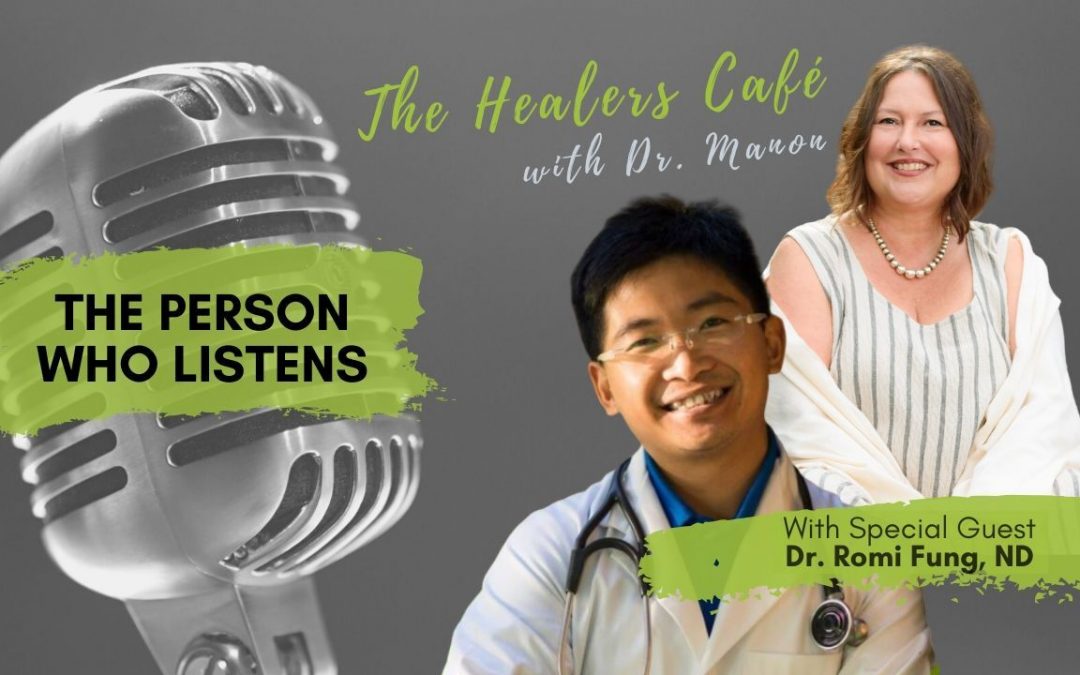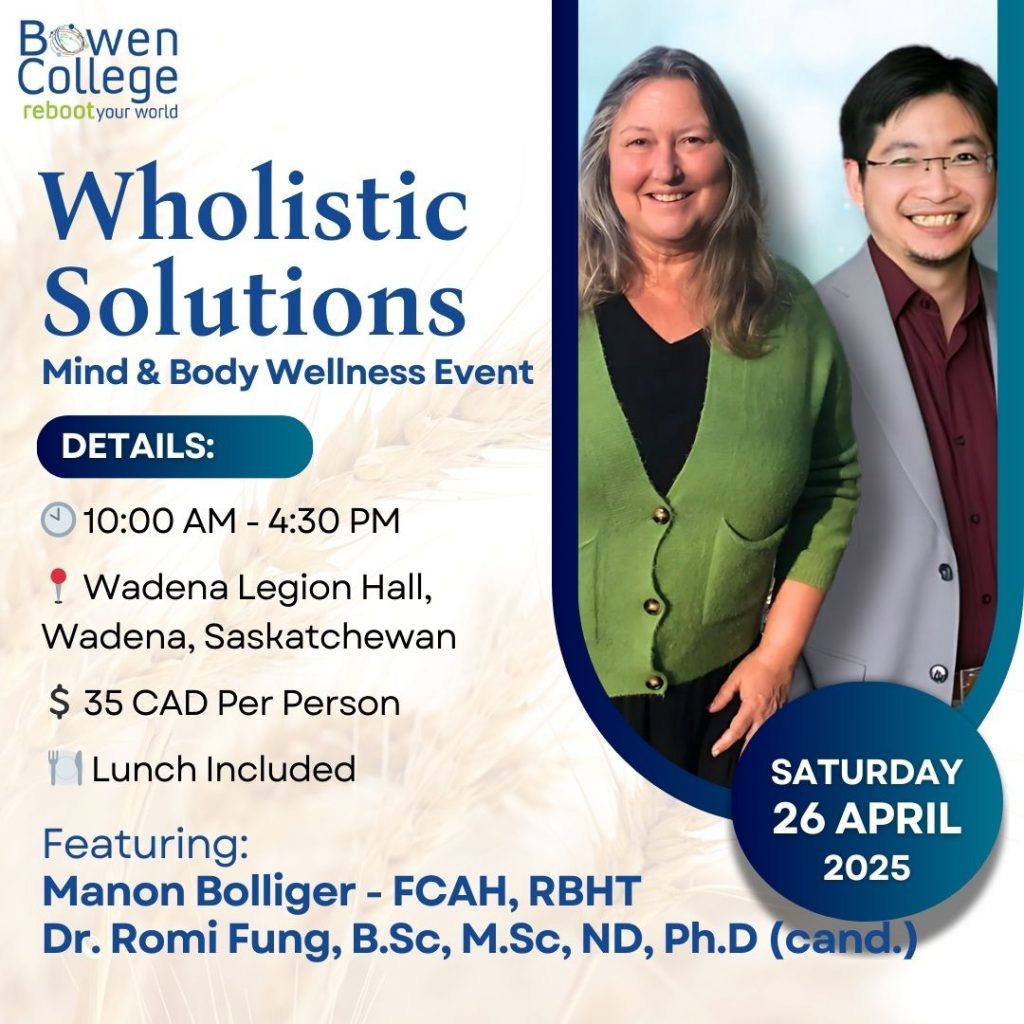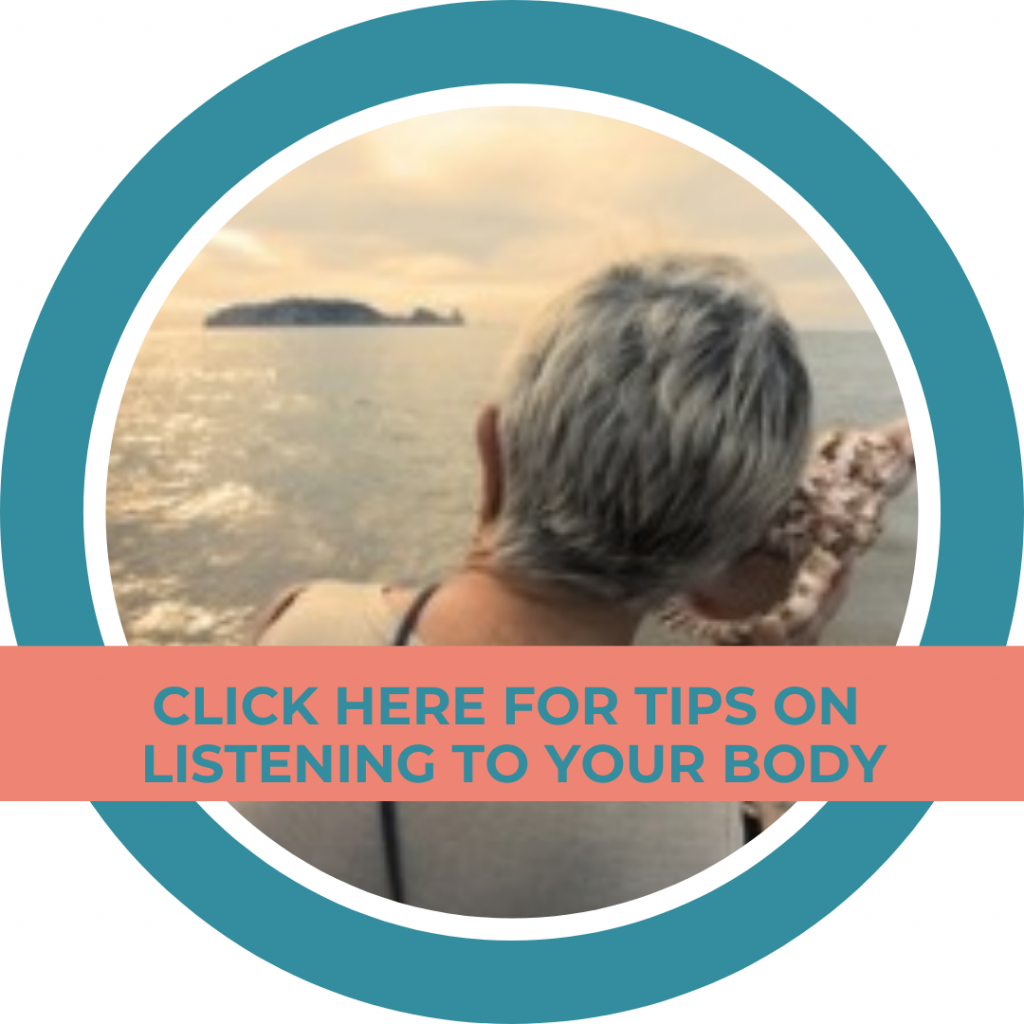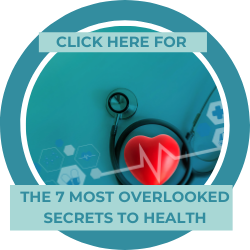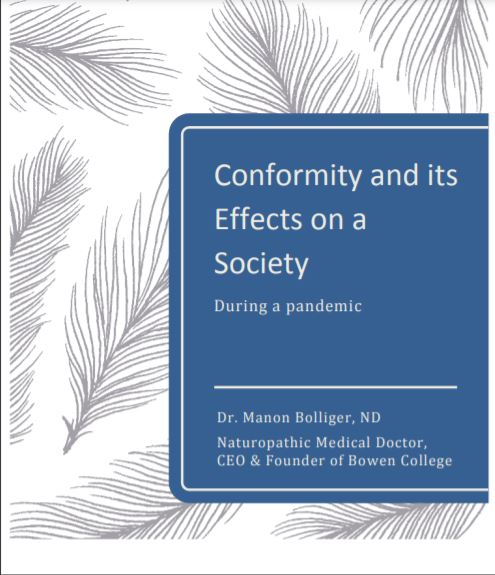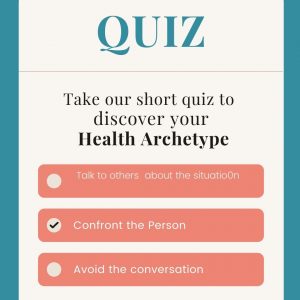I wanted to be that person that listens: The Healers Café with Dr. Manon & Dr Romi Fung, ND
In this episode of The Healers Café, Dr. Manon chats with Dr. Romi Fung, ND. Highlights from this episode include:
Dr Romi Fung (08:53):
It’s how we apply what naturopathic modalities and naturopathic principles there are but naturopathy is the use of, as it states natural or natural substances in supporting the body’s own innate ability to heal. And under naturopathy or naturopathic medicine, there are principles that we abide by and that’s what we call the naturopathic oath. So being first do no harm That whatever we provide, we assess for the risk of harm and making sure that whatever we suggest has the most minimal of harm possible. And then others involving, treating the root cause, doctor as teacher, which I’m very big on and so forth. And amongst naturopathic medicine, there are modalities that we utilize. So with physicians, conventional physicians and conventional medicine utilizing more so pharmaceuticals, even though naturopathic doctors are trained in the pharmaceuticals, we also utilize nutrition and physical medicine, counseling techniques, homeopathy. What else am I missing? Botanicals. Botanicals. Yeah. And so, and, and lifestyle because that’s what we have to focus on in regards to focusing on the simplest, but also the foundations of our health. The pillars of our health.
Dr Romi Fung (21:12):
But this patient came in and literally within minutes of our consultation she bursted out in tears. She was going through a lot of stress, especially with family and she didn’t know how to handle it. And she felt almost helpless. And for 30 minutes we talked about it. I thought it would give her the space for her to be heard. And for me to really understand like this is probably the important part, that I probably play a role more so than most other practitioners is allowing myself to be in the shoes of my patients.
Dr Romi Fung (21:58):
I’m trying to figure out what’s really happening. And I thought to myself, you know, I had a bit of extra time. She’s expressed a lot and she felt as though we can definitely do something, but I really felt like I couldn’t leave her at that point. I was afraid or I was scared that she would potentially harm herself. And even though we have instances where we can contact professionals to make sure that they’re properly addressed, I needed to do something that would get to her immediately. And that’s when I said to her, let’s get you on the table. I’m going to do a quick session on you. I’m going to do something called Bowen therapy. And we got to it. And I did the basic moves aims one, two, and three. And by the end of it, I looked at her and I looked at her face, she looked a lot more focused, and then she looked at me and she was like, I’ve never felt this clear before in like the past few months.
Dr Romi Fung (23:08):
And then she started tearing again. But then she told me that this is not because I’m sad, but these are tears of joy. And so it was from that moment then we decided, you know, let’s get a plan going. And that’s when I decided to add in the the naturopathic elements, making the nutritional work and lifestyle. But, and I mean I liked Bowen therapy as a standalone treatment as well as a combination because it’s so complimentary. But by putting them together, you don’t really know which one works and which one does it.
About Dr. Manon Bolliger, ND:
Dr. Manon is a Naturopathic Doctor, the Founder of Bowen College, an International Speaker with an upcoming TEDx talk in May 2020, and the author of the Amazon best-selling book “What Patient’s Don’t Say if Doctors Don’t Ask.” Watch for her next book, due out in 2020.
SOCIAL MEDIA:
Dr. Manon, ND – Facebook | Instagram | LinkedIn | YouTube | Twitter
About The Healers Café:
Dr. Manon’s show is the #1 show for medical practitioners and holistic healers to have heart to heart conversations about their day to day lives.
Follow us on social media! https://www.facebook.com/thehealerscafe
About Dr Romi Fung, ND:
Email: | [email protected]
Website: https://www.DrRomiFungND.com
Facebook | Instagram | LinkedIn | YouTube |
TRANSCRIPT
Welcome to The Healers Café . Conversations on health and healing with Dr Manon Bolliger, ND
Dr Manon (00:26):
Welcome to The Healers Café, and today I’m with Dr Romi Fung and he is a naturopathic physician. Let me just tell you a little bit about him. So prior to his education in naturopathic medicine, he graduated with a health science from Simon Fraser university with a focus on applied bioethics, pharmacology and cell pathophysiology. And he’s currently pursuing his education at Queens university to obtain a master’s degree in aging and health while he’s also building his practice and his research project consists of a scoping review of efficacy of curcumin in the treatment of Alzheimer’s disease. He is also Bowen therapist and that’s we met. Well, actually we might’ve met. Yeah, that is probably how we met. Anyhow. So welcome. And it’s really a pleasure to have you on the show. Thank you very much. Well, you know there’s so many things we can talk about. Definitely. I want to talk about your study on aging. Let me start with the same question. I ask everybody else what brought you into the healing profession of the healing arts or whatever you want to call it, but what, what actually started all this for you?
Dr Romi Fung (02:02):
Always really hard to look back. And I think the funniest thing if I may to bring this up,of course the cliche is I’ve always wanted to be a doctor. I know growing up since I was young, maybe even as young as five or six, I’ve always wanted to be a doctor, but there is that specific question, what kind of doctor? And that kind of fluctuated throughout my childhood. But whilst I was growing up, I was exposed to, you know, a lot of your, your typical growing boy and his video games and every video game I’ve played had to do with role playing. So, and every single game that I’ve played, I’ve always taken the role as healer, whether that be healer, cleric, priest, high priest, whatever. I’ve always took enjoyment and in playing that role, whether or not that’d be on my own or as a group or as a team.
Dr Romi Fung (03:04):
And that kind of really emphasized growing up, knowing that I wanted to be in the healing arts. And then of course, having seen my doctor quite often when I was growing up, I grew up with a few health conditions, one of them being a very sensitive gag reflex. And I think I saw about, more than a dozen doctors in regards to that even though they didn’t really have the answer for it. It was seeing them and watching them conjecture, you know, their diagnosis and making sure that you were cared for. And that really built my kind of understanding in medicine and also thinking, you know what, this is probably the location that I see myself working at. And so it wasn’t until I encountered a few challenges along the road, so one of them being shortly upon entering high schoo I was bullied and I didn’t really have much support coming in from the family.
Dr Romi Fung (04:09):
And then I fell into a state of depression and that took me out of school for quite some time. In fact, maybe .. Approximately five years. So officially I didn’t at start high school until I was 18. But during the five years I went through medication and so I was prescribed quite a few antidepressant and anxiolytics, so Zoloft, Prozac, etc. I went through numerous counseling and I was even hospitalized on a couple of occasions overnight just because I had some suicidal ideations. I guess. I didn’t know what I really wanted in life afterwards. And it wasn’t until I got to my most recent counselor and she told me that there’s nothing wrong with you. I want you to start volunteering anywhere. And so we worked together and she taught me volunteering at a daycare.
Dr Romi Fung (05:23):
I tended to children and that’s when it kind of all sparked up again. So I think healing was one thing, but the second part of my journey, which is a big emphasis right now, is passion. And so I think I found kind of like the passion or even being able to help someone is I think helping someone reaching out, a hand listening, et cetera. It’s also not only therapeutic for the recipient, but also for the one who’s providing it. And so the more I volunteered in different occasions in different situations, so I volunteered at senior homes, senior centers, that was pretty much the majority of my exposure, which got me into my Alzheimer’s studies and research and many other locations that really built up why I’m here in the first place.
Dr Manon (06:29):
Wow. That’s definitely parts I did not know! What a journey to go through that too.
Dr Manon (06:37):
And also just to notice, it was one person, the act of one person who said, Hey, try this instead. Because otherwise it’s, it’s kind of all the same and everyone has that choice, you know, and somebody made or recommended a different choice, so it’s interesting and really shows how on one level, you need to be open to it. and the other thing is doctors have to dare to share, and be aware of, there’s not one fit for all people. Right. what a huge impact. Oh my goodness, what a turnaround.
Dr Romi Fung (07:25):
and exactly what you said, there’s not that just one level. So having gotten back on my feet and started high school at 18, I thought to myself, what was it before that I really thought about, and that was to become a doctor.
Dr Romi Fung (07:42):
But after going through that experience, I really wanted to be that person that listens. Counseling was something that I really became attuned to right shortly after I got exposed to, acupuncture. And that helped a lot greatly actually with my sensitive gag reflex with my passion for nutrition. I did that Google search. I mean there’s Google everywhere now, but I Googled nutrition, acupuncture and counseling, naturopathic medicine. Hmm. that makes sense…..Yeah….
Dr Manon (08:21):
why don’t you share a little bit? What, is naturopathy? we,re both naturturopaths probably you,ve probably read the latest research i havent been in the field for 30 years. So I can’t remember what’s the official, stance !what is it that naturopaths do? So why don’t you share a little bit about that?
Dr Romi Fung (08:43):
definitely. But I think more so everyone has their own perception of what naturopathy is and what medicine is.
Dr Romi Fung (08:53):
So I think it’s not that there’s one exact answer. It’s how we apply what naturopathic modalities and naturopathic principles there are but naturopathy is the use of, as it States natural or natural substances in supporting the body’s own innate ability to heal. And under naturopathy or naturopathic medicine, there are principles that we abide by and that’s what we call the naturopathic oath. So being first do no harm That whatever we provide, we assess for the risk of harm and making sure that whatever we suggest has the most minimal of harm possible. And then others involving, treating the root cause, doctor as teacher, which I’m very big on and so forth. And amongst naturopathic medicine, there are modalities that we utilize. So with physicians, conventional physicians and conventional medicine utilizing more so pharmaceuticals, even though naturopathic doctors are trained in the pharmaceuticals, we also utilize nutrition and physical medicine, counseling techniques, homeopathy. What else am I missing? Botanicals. Botanicals. Yeah. And so, and, and lifestyle because that’s what we have to focus on in regards to focusing on the simplest, but also the foundations of our health. The pillars of our health. Yeah.
Dr Manon (10:42):
I too was in a strange position ..differently, but you know, deciding what to do. And it was all, you know, looking and hearing well what’s the difference between a medical doctor or a naturopathic doctor? And I was also like, well, what is the difference? And I mean it came down to, well, everything we learn, whether it’s reading, x-rays assessing blood work, lab work, microbiology, understanding all that, that’s all the same. It’s in the choice of how we treat and the philosophy behind what we’re doing. are we finding a way to manage the symptoms people have or are we actually, like you said, getting to the root? What is the cause, and with a very simplistic kind of thinking, I went, well my goodness…..if we can get to the cause, let’s get to the cause, let’s find out what’s really going on.
Dr Romi Fung (11:48):
the whole idea of managing and then, pharmacology, we have to do it as part of our training. And I think now I think everyone has to do it at this stage, right? I believe. I think so. Yeah. And that’s great. That was fun to find out the side effects and to help, you know, because in my time we weren’t allowed to prescribe. When I first started my practice, we were allowed to tell people, go back. Because by the way, this drug and this drug, you shouldn’t have them together in the same body, you know? So at first I, I became really interested in this, but also, a little weary about it and all of that. So anyway, my decision was pretty clear to go into the cause I’m doing no harm and you know, and find natural ways because ultimately the body is incredible. Right. So, you know, so that’s very interesting. So, so then you went you went into naturopathy and then what happened ?
Dr Romi Fung (12:55):
So it was in the middle of naturopathic school. So I did my training at the Canadian college of naturopathic medicine and I think it was sometime either late in my first year or early second year
Speaker 3 (13:15):
When I encountered Bowen therapy. And I thought to myself, what is this? And why is something you barely touch someone can have such a profound effect. But the more I looked into Bowen therapy and how it really gets the body onto the parasympathetic and really respecting the body on its own innate ability, I’m saying to myself, this is pretty much the hallmark of naturopathic medicine. And then I had to dig pretty deep into the bone therapy and pretty much got myself addicted to it instantly. Of course I went through trainings elsewhere first and it wasn’t until I got, once I finished my naturopathic training in 2016 and having come back to Vancouver, British Columbia, that I had some time to really reconciliate to it. Do I really want to go for this or not? And so that’s when I decided to transfer into Dolan college. i Haven’t turned back ever since.
Dr Manon (14:30):
I can see with your history now that I understand much more why that would be a perfect fit. I do see that because I mean the thing is ……..it is the part of Bowen that also got me so excited. It is exactly what we, it’s our foundation. You know, it’s like really literally working with the body because the body has the answer because of the body has its own powerful understanding that we may not fully understand yet. Right…… how do you deal with that?you’re now doing a master’s, you’ve got all this, science behind you. How do you deal with the missing pieces that have what we don’t know? You know, like, I mean, it happens, right? Like we don’t know everything. And how do we, how do you deal with what you don’t know because you see results clearly, otherwise you wouldn’t be enamered with it. But how do you deal with that internally?
Dr Romi Fung (15:37):
I think for me going back to my roots again with my childhood experience, it’s about listening. So when I get someone asking me how does this work, I mean truly there’s no quote unquote evidence or per se, but I think
Dr Romi Fung (15:57):
What first we have to do is to listen.
Dr Romi Fung (16:01):
That’s what the body has been telling us all along. We don’t get a headache for no reason. We don’t get a headache because their body wants to torture us with It’s a signal coming from the body. And even though we may not have the ability or the capabilities of fully understanding those signals, a lot of these signals, we can come to think that it has to be first dealt with by the patient, listening in on what they’re experiencing first and foremost. And then it’s a matter of, you know, let’s work with what the body is showing first and then really see what the body is saying afterwards. So all of the matter is come do it first and you will understand what it means.
Dr Manon (16:56):
it was worse. 30 years ago. I can promise you … there wasn’t even parts of science that we could really even use to understand it, but now with, so much more research on how, like even neuroplasticity, even that concept, you know, didn’t really,……. well, it may have existed, but it wasn’t talked about fascia, you know, and the entire matrix wasn’t even talked about.we didn’t really…… And sympathetic, parasympathetic, yes, but the impact of parasympathetic on healing wasn’t talked about. You know, there were studies that, they would put people with I forgot what that’s called…… like with the heart monitor. What does like ECG, what are those called, those pads that measure the electrical electrocardiogram……. any of those, whether it’s for the brain, or the heart, like an amalgam. I’ve used it for meditation, but they also have used it to notice when bone healing takes place right. When osteo blastic activity happens, right? Like osteoblastic is one when it builds. This is for anyone in the audience that doesn’t know the, terms I’m not trying to use big words and osteoclastic is when, the bone gets reabsorbed or I’m eaten up physically and they notice that you had to be in a deeper state of rest….
Dr Manon (18:49):
Sleep of which parasympathetic is really the condition. So it’s like that when I read those studies, I went, Oh, interesting. This is explaining to me why on some level people heal so quickly because we’re putting them in that state before we do, we work with them. Right. And, and I think listening and connecting the context, like I don’t want to emphasize that because that’s massively important that you’re, you know, you feel heard and then there is a thing that happens, you know, an action that we’re starting to understand, much more so you know, and there are some studies we really need a big study,a mega study to show the impact of this. I would love to get that going, because it’s an interesting thing to see how our reproducible it is and how many people are getting incredible results, So have you had any skeptical patients? I had my fair share of skeptical patients. I love those.
Dr Romi Fung (20:07):
Yeah. I think, well not just skeptical, but coming in with not knowing what to expect and i have quite a few patients that come in where they want to. Well of course people are going to walk into your doors looking for a solution, but they don’t even know what that solution is. And in most cases, most people are not going to be expecting to hear the term Bowen therapy. So I think one of my most profound cases, not just with Bowen therapy as in Bowen therapy on its own, but in the realm of mental health to use, a lot of people are going to see Bowen therapy as a hands on physical touch. But it was that, it was this physical touch that really got the mental and the emotional going. And with this case I had a a lady in her mid fifties coming in and her friend was someone that introduced her to see me.
Dr Romi Fung (21:12):
But this patient came in and literally within minutes of our consultation she bursted out in tears. She was going through a lot of stress, especially with family and she didn’t know how to handle it. And she felt almost helpless. And for 30 minutes we talked about it. I thought it would give her the space for her to be heard. And for me to really understand like this is probably the important part, that I probably play a role more so than most other practitioners is allowing myself to be in the shoes of my patients.
Dr Romi Fung (21:58):
I’m trying to figure out what’s really happening. And I thought to myself, you know, I had a bit of extra time. She’s expressed a lot and she felt as though we can definitely do something, but I really felt like I couldn’t leave her at that point. I was afraid or I was scared that she would potentially harm herself. And even though we have instances where we can contact professionals to make sure that they’re properly addressed, I needed to do something that would get to her immediately. And that’s when I said to her, let’s get you on the table. I’m going to do a quick session on you. I’m going to do something called Bowen therapy. And we got to it. And I did the basic moves aims one, two, and three. And by the end of it, I looked at her and I looked at her face, she looked a lot more focused, and then she looked at me and she was like, I’ve never felt this clear before in like the past few months.
Dr Romi Fung (23:08):
And then she started tearing again. But then she told me that this is not because I’m sad, but these are tears of joy. And so it was from that moment then we decided, you know, let’s get a plan going. And that’s when I decided to add in the the naturopathic elements, making the nutritional work and lifestyle. But, and I mean I liked Bowen therapy as a standalone treatment as well as a combination because it’s so complimentary. But by putting them together, you don’t really know which one works and which one does it. Yeah. But this was
Dr Romi Fung (23:46):
One of those cases where I did it first before I could even do anything else and look at how much power there was just right at the end of that session, she felt so motivated that she was willing to even do what I recommend with the naturopathic approach.
Dr Manon (24:04):
Yeah, you hit the nail. I think the English expression, the nail on the head is on how it’s like, Oh yeah. So yeah, it, you know, in..at least in my Clinic, that’s the experience I would have to have once the patient feels that their body is capable of such tremendous shifts. You know, it’s like now it’s like whatever you might offer to them, what else you might offer there. They’re listening, you know? Whereas before it’s like, Ugh, it’s almost like they drive themselves here or somebody told them to go, but they’re not committed.
Dr Manon (24:41):
they don’t have a, felt sense of like that their body can do anything. because we live in a culture that says I can’t do much, you know, or, or guilty about whatever you do, but not in love with the incredible power with it. Right. !my specialty was pain, so it’s like I had to do pain first because if you don’t get people out of pain, it doesn’t matter. Whatever you tell them, they, you know, it’s like, ah, just take the pain away. But it’s interesting with your specialty in in mental illness or I think we’re not allowed to say specialty, your special interest in mental health to correct, to be politically correct. But your passion for your experience throughout all these years in in helping like what yeah, it’s, it’s fascinating to see that shift and how powerful that is.
Dr Manon (25:46):
Anyway, I want to shift a little bit because I realized I want to make sure we talk about your, Alzheimer’s and also your project curcumin. So maybe share a little bit about that.
Dr Romi Fung (26:00):
So I’ve worked with a lot of seniors and the easiest thing I could say is I’ve worked with seniors for pretty much almost two decades of my life. And I know that my respect for the geriatric population is, so great that because they’ve practically founded our society today and that’s probably the foundation of my interests in dementia and Alzheimer’s disease. So that’s what got me thinking that. And with the naturopathic elements, it’s about getting into the root of all things. And through
Dr Romi Fung (26:44):
My studies and research in working with Alzheimer’s, there’s now a lot of correlation between Alzheimer’s disease and the underlying cause. So Alzheimer’s disease is not just Alzheimer’s disease, it’s at least as according to what Dr. Dale Bredesen who founded the Bredesen protocol States that it’s at least 36 different contributions to the development of Alzheimer’s. And so that’s what really got me thinking about each and every component and gone and getting me back into my a masters in aging and health. And so through my masters learning about the, the approach of aging with respect to the different theories and socio-economical and all that. But the biggest part was my research on which is a scoping review on the efficacy of curcumin and Alzheimer’s disease. And right now it’s up to date and there’s not much in terms of the evidence I found out of all the research, there is seven studies to do with them, randomized control trials for the use of curcumin.
Dr Romi Fung (28:07):
And one of the things that’s lacking in these studies is the length of time. Most of the studies were done within six months to a year when it takes maybe two to thirty years, 20……..30 years before you actually get to that diagnosis of dementia. So it really got me thinking that we need more, more research on this, but the sites having the length of time or the length of period of the research being six months to a year, one of them being 18 months, the evidence shows that there is still a positive shift by approximately one point positive when you’re taking on something called mocha or the Montreal cognitive assessment, which is a questionnaire used to measure the extent of your dementia. And so working with the masters has been quite interesting, especially when you’re balancing, you know, a practice and building a practice. And I’m very excited to share that. I might be even bringing that research into my PhD starting in September.
Dr Manon (29:17):
So just to kind of educate everyone, including including me Like you’re testing curcumin because I mean it has other properties, but one of them isn’t it antiinflammatory properties. what else is out there for?
Dr Romi Fung (29:45):
It has been shown to have not just the antiinflammatory but also a lot to do with anti cancer anti antioxidants. So knowing that a lot of chronic diseases including dementia, Alzheimer’s, diabetes, et cetera, has the so called oxidative stress and curcumin has a really good amount of antioxidant levels. There has been a lot of research starting with animal studies showing that curcumin itself can really help with preventing or even desolving the beta amyloid plaque, which is cognizant of the diagnosis of Alzheimer’s disease. It’s that sticky material that’s stuck in the brain and that’s preventing the brain to undergo its own impulses. And thus the communication between the brain is then compromised. So that’s one of the theories of Alzheimer’s disease and his production of beta amyloid is probably one of the things.
Dr Romi Fung (31:00):
However, there are other things that we are discussing that it’s likely not beta amyloid. Because again, back to our, the beginning of our talk, our body is so smart that it actually wants to protect itself. And one of the other theories is that beta amyloid is actually a protective mechanism. But what is it protecting against? We’re still not sure. One of those theories is something to do with bacteria that the brain is trying to protect itself from the bacteria that’s actually been found in the oral cavity. So there might be a link between oral hygiene, oral health and dementia and Alzheimer’s. But to get back to curcumin, a lot of people will link, you know, you have Alzheimer’s disease, try curcumin. It’s probably one of those mainstream thoughts that has yet to be brought into light. And my interest from there is hoping that I would bring that into light.
Dr Manon (32:06):
So because you started saying that there’s, you know, multitude of factors. I think you said 36 or 39 and then they name it this name, but like so many conditions it’s, multidimensional and, multi causative because we’re complex human beings. So it kind of makes sense. Right…. To study one thing and see what the one thing does. So I understand the limitation of the model, but what, what made you interested in curcumin as opposed to many of the other potential components that could be a contribute
Dr Romi Fung (33:02):
Yes, definitely. I think looking at it. So just backtracking to how there’s maybe 36 different aspects or different contributors and we can group them to subtypes as Dr Bredesen called it. The first type being inflammation. And when I think of inflammation as a, comparison to a lot of people, they think curcumin and inflammation is probably one of those biggest links to the development of dementia, Alzheimer’s diseases as well as any other chronic condition. So I thought, why not study those with the biggest contributors as anti-inflammatories and see how that works in regards to the inflammation component of, of Alzheimer’s. Because you ask anyone, you know, I have inflammation, one of the most common answers is going to be curcumin. And then there’s also a lot of epidemiological studies that show that those who live in India have a 4.4 times less risk of developing dementia as opposed to those in North America.
Dr Manon (34:30):
Do you think that’s because curcumin is part of the culture……its Likely that’s, that’s, that’s the most interesting thought about it. So potentially potentially, we don’t know this till the studys out, but adding it could be into your, food basically could be one of the ways of averting this to decrease inflammation in your body
Dr Romi Fung (35:03):
Potentially. As long as you make sure that if you do consume curcumin Curry, tumeric and you consume it with a source of fat because it is fat soluble, it needs to be involved in fat in order to be absorbed. And also you need something called piperine, which is a component in black pepper. And there’s some evidence that shows that by adding a certain amount of piperine that actually increases the absorption of curcumin by as much as 2000%.
Dr Manon (35:38):
Huh. So they really had it together. I crave Indian food I love it. You cant go wrong with Indian food. Interesting. Okay, so our time is up, but is there any last statement or share this has been fascinating and that you would like to share? I think
Dr Romi Fung (36:06):
Everyone has, has a story. And I think if anything, the best
Dr Romi Fung (36:12):
Way to go around that is to make sure that you listen, listen to yourself, listen to your environment, listen to your own kind of, what’s the term I’m looking for? And like instinct is, I don’t think we become healers overnight. I don’t think there is such a thing.
Dr Manon (36:38):
once you so-called become one, you realize it isn’t you. It is the other. Exactly. It’s an endless journey of greater consciousness and openness, you know? So anyway, that’s what I’ve really appreciated about getting to know you a little bit more. So you’re very much exemplary of that.
Dr Romi Fung (37:07):
Thank you very much. It’s been a pleasure and even an honour just to be, a part of what I do, not only as a naturopathic physician and also as a Bowen therapist, but to be, sharing that with others too. That’s why I thank you for having me on here and for, you guiding me through Bowen therapy and, and beyond. Right. Okay. Well thanks very much .
